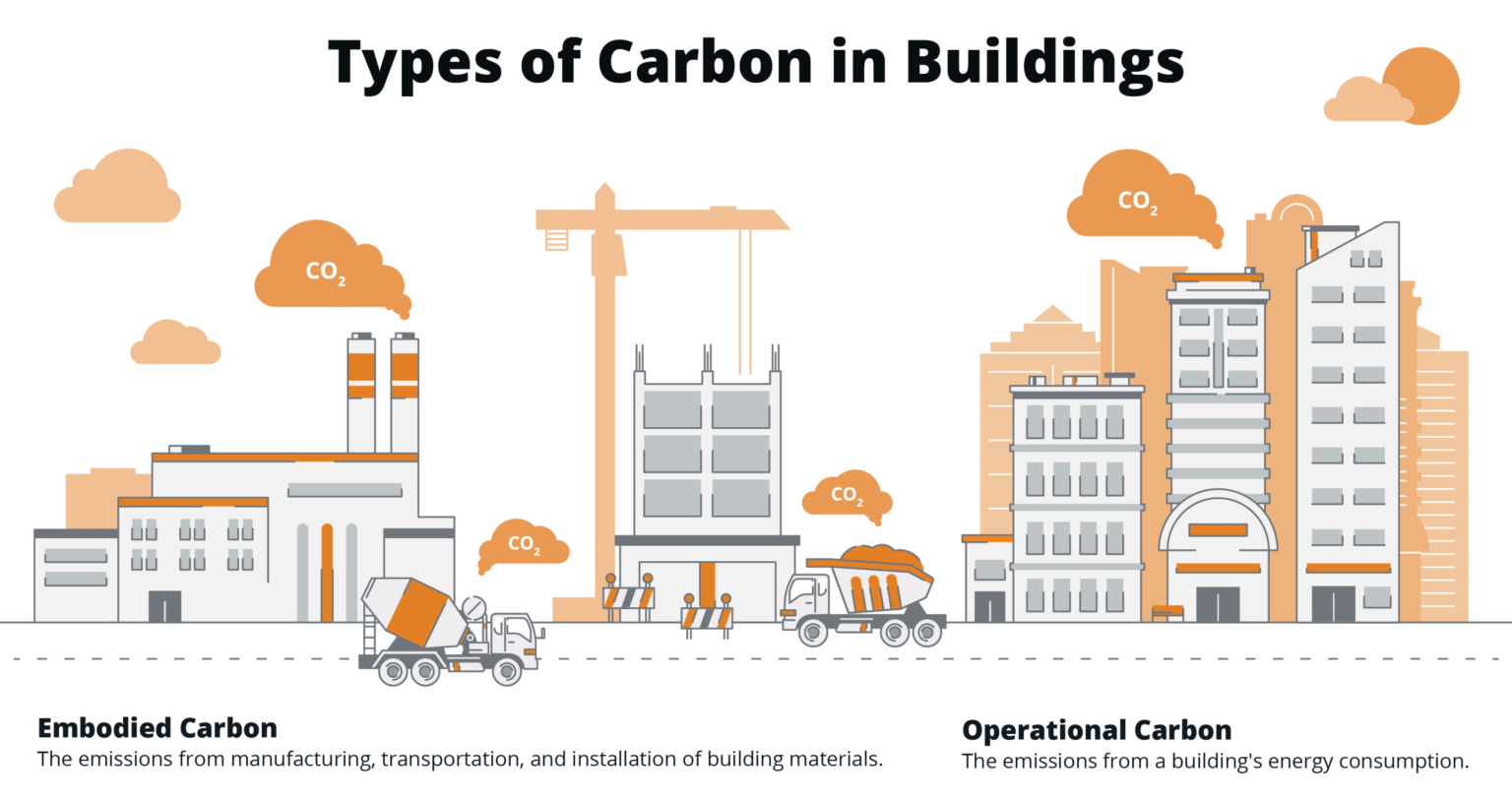When it comes to buildings, the choices of construction materials can have a significant impact on the environment. One important aspect of an eco-friendly construction project is choosing energy-efficient, low-carbon footprint building materials.
For example, the production of concrete results in a large carbon footprint, while the use of sustainable wood can help reduce the footprint.
Sustainable wood can help reduce the carbon footprint of a building in two ways. First, the trees used for the wood absorb carbon dioxide from the atmosphere as they grow. Second, wood is a renewable resource, so it can be replaced after it is used.
Concrete is one of the most common materials used in construction, but it is among the worst when it comes to low-carbon footprint building materials. The production of concrete as well as its transportation to a construction site releases carbon dioxide into the atmosphere.
Steel is another common building material with a large carbon footprint. Aluminum, while having a much smaller carbon footprint than steel, is still a strong culprit for emissions.
As you can see, the choice of materials used in construction can have a significant impact on the environment. When choosing materials for your next building project, consider the carbon footprint of building materials.
Table of Contents
What Is a Carbon Footprint?
When you hear the term carbon footprint, you probably think about your personal impact on the environment.
But did you know that the buildings we live and work in also have a carbon footprint?
Construction materials like concrete, bricks, and steel are responsible for a significant amount of greenhouse gas emissions. In fact, the production of cement (a key ingredient in concrete) is estimated to account for about 7% of global emissions.
So, what can we do to reduce the carbon footprint of our buildings?
One option is to use more low-carbon footprint building materials. For example, bamboo is a quickly renewable resource that can be used in place of wood while straw bales can be applied as insulation.
Another way to reduce the carbon footprint of buildings is to design them for energy efficiency. This means using materials that help keep the building cool in the summer and warm in the winter. It also involves installing energy-efficient appliances and lighting.
As we continue to urbanize and build more infrastructure, it’s important to consider how our construction materials affect the environment.
Fortunately, there are a variety of low carbon footprint building materials that can be used in construction projects large and small. Materials such as bamboo, rammed earth, and recycled steel can help reduce the environmental impact of your construction project.
By making small changes to the way we build, we can have a big impact on the environment.
8 Most Energy-Efficient Building Materials
Looking to build a more energy-efficient building?
Here are eight low-carbon footprint building materials that you can choose from.
- Bamboo. An excellent alternative to wood.
- Hemp. Another great alternative to wood.
- Straw. Straw is an excellent insulator and can be used to build walls, ceilings, and floors.
- Cork. Another great insulator. It’s also fire-resistant and has excellent acoustic properties.
- Wool. Another excellent insulator.
- Recycled Plastic. An excellent alternative to concrete.
- Recycled Glass. An excellent alternative to brick.
- Recycled Metal. An excellent alternative to steel.
These are just a few of the most energy-efficient building materials.
By using these materials, you can greatly reduce the carbon footprint of your workplace.
Why You Should Care About Reducing Your Carbon Footprint
It’s no secret that climate change is a huge problem. The Earth is getting warmer, the ice caps are melting, and extreme weather events are becoming more and more common.
Scientists are warning that we need to take action now if we want to avoid the worst consequences of climate change.
One of the most important things we can do to fight climate change is to reduce our carbon footprint.
Carbon dioxide is one of the main greenhouse gases that contribute to climate change, so by reducing our emissions of CO2, we can help make a difference.
There are a lot of different ways to reduce your carbon footprint.
You can drive less, fly less, eat less meat, and waste less food. You can also make sure your workplace is energy-efficient and that you’re using renewable energy sources.
But one of the most important things you can do to reduce your carbon footprint is to use building materials that have a low carbon footprint.
Building materials are responsible for a huge amount of CO2 emissions, so by using low-carbon materials, you can make a big difference.
There are a lot of different low-carbon building materials available, including bamboo, hemp, wool, and straw. Using these materials can help you build a more sustainable establishment that has a smaller impact on the environment.
It’s one of the best things you can do to fight climate change.
 (Source)
(Source)
FAQs About Carbon Footprint Building Materials
What building material has the best carbon footprint?
In terms of sustainability, rammed earth is one of the least harmful methods, as it only utilizes natural materials such as soil, sand, and stone. It is one of the most eco-friendly construction techniques.
What are high-carbon building materials?
Materials such as steel, concrete, and wood have some of the highest levels of embedded carbon emissions, but so do all the materials inside a building, including carpets, paint, insulation, and plaster.
What is the carbon footprint of a building?
The CO2 footprint of buildings is the total greenhouse gas emissions throughout the entire building process. This includes operational carbon emissions, which are created during the actual running of the building, and the greenhouse gasses emitted during the production of building materials.
What material has the highest embodied carbon?
Because of its abundance and weight, reinforced concrete has the highest carbon footprint among building materials.
Conclusion
There are many ways to reduce the carbon footprint of a building, but one of the most effective is to choose energy-efficient, low carbon footprint building materials. These materials help save energy in both the construction and operation phases of your building.
By using these eight most energy-efficient building materials, you can significantly reduce your carbon footprint and make a positive impact on the environment!
{“@context”:”https:\/\/schema.org”,”@type”:”FAQPage”,”mainEntity”:[{“@type”:”Question”,”name”:”What building material has the best carbon footprint?”,”acceptedAnswer”:{“@type”:”Answer”,”text”:”
In terms of sustainability, rammed earth is one of the least harmful methods, as it only utilizes natural materials such as soil, sand, and stone. It is one of the most eco-friendly construction techniques. “}},{“@type”:”Question”,”name”:”What are high-carbon building materials?”,”acceptedAnswer”:{“@type”:”Answer”,”text”:”
Materials such as steel, concrete, and wood have some of the highest levels of embedded carbon emissions, but so do all the materials inside a building, including carpets, paint, insulation, and plaster. “}},{“@type”:”Question”,”name”:”What is the carbon footprint of a building?”,”acceptedAnswer”:{“@type”:”Answer”,”text”:”
The CO2 footprint of buildings is the total greenhouse gas emissions throughout the entire building process. This includes operational carbon emissions, which are created during the actual running of the building, and the greenhouse gasses emitted during the production of building materials. “}},{“@type”:”Question”,”name”:”What material has the highest embodied carbon?”,”acceptedAnswer”:{“@type”:”Answer”,”text”:”
Because of its abundance and weight, reinforced concrete has the highest carbon footprint among building materials.





